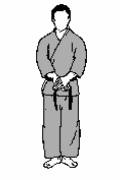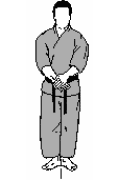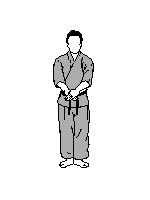A Brisk Introduction to Karate

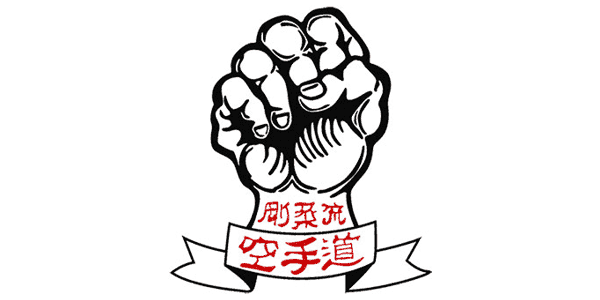

What are the basic forms of Karate? What is Karate?
“The ultimate aim of karate lies not in victory or defeat but in the perfection of the character of its participants … to subdue the enemy without fighting is the highest skill, know your enemy and know yourself, in a hundred battles you will not be defeated” says Gichin Funakoshi —known as The Father of Modern Karate.
Karate means “empty hand” and was developed on the island of Okinawa —part of modern-day Japan. The major styles (“Ryu”) are Shotokan, Wado-ryu, Shito-ryu, and Goju-ryu —many other styles of Karate are derived from these four. I'm focusing on Goju-Ryu in this article: Goju-Ryu was founded by Chojun Miyagi; whose colleague, Gichin Funakosi, founded Shotokan-Ryu.
Occasionally one sees Karate-Do, which means “the way of the empty hand”. This usage is a reminder that Karate is not just about fighting, but is also a spiritual discipline.
The basic form of Goju-Ryu karate is Sanchin, “3 battles”: The battles of the mind, the body, and the spirit. However, this was considered a bit difficult for beginners, and so new forms were needed as a way of introducing fundamental karate forms to a wider audience. There are the “peaceful and safe” forms known as Pinan/Heian, the “first course” or Taikyoku forms, the “popularising forms” known as Fukyugata —the second of which was rebranded as “attack & smash”, Gekaisai— and, finally, there is the so-called Dachi-waza form. This last one is relatively new, and aims to be a smooth introduction to the world of forms/Kata.
In this article, I'd like to discuss the basic forms and their relationships.
1. Kata: Learning by Patterns
Kata means “forms”, which are patterns used to learn sequences of techniques. Besides teaching kicking, strikes, etc; the repetition of patterns/Kata improves physical conditioning and muscle memory.
- Interestingly, the phrase “kata” is used in Software Engineering for the same goals: To refer to “families of similar (coding) problems” which may be solved using an existing set of “design patterns”.
In general, repeating a fixed pattern over and over —i.e., “doing kata”— reinforces the knowledge of fundamental techniques and stances via repetition. However, there are numerous other benefits:
- Solo Practice
- Training without a partner is important, since you can then train whenever and wherever you want. E.g., at your lunch break at work.
- Mucle Memory
- Repeatedly practicing kicks, strikes, blocks, etc, means it will become easier to perform them, and doing them in fixed sequences means your body will internalise different combinations. E.g., middle-block, followed by forward-punch, and concluding with a snap-kick.
- Improved Fitness
Doing a kata, while focusing on your breathing & stances, is itself a quick workout. Adding weights, or doing the kata on your toes only, or doing them slowly, or with extra power, not only provide a challenge but also make the kata into a sort-of moving meditation: Gichin Funakoshi says, In traditional karate-do, we always keep in mind that the true opponent is oneself.
- Of-course “real opponents move fast”, so one can also try practising the kata at increased speeds, but ensuring the techniques are performed correctly.
- “Imaginary opponents don't hit back”, so the addition of weights, or the use of extra power, can be used to compensate.
When you train, do so as if on the battlefield. Your eyes should glare, shoulders drop, and body harden. You should always train with intensity and spirit and in this way you will naturally be ready. —Anko Itosu
- Safety
Dangerous techniques can be practised without anyone getting hurt. E.g., leg breaks, or the use of weapons, can be practised against an imaginary opponent before actually practising with a real person.
Do not think that you have to win, think rather that you do not have to lose. —Gichin Funakoshi
- Application / Bunkai
- When fixed patterns are already learned, one can adapt
them to various real-life situations involving another person. I personally
liked it when the teacher would explain immediate applications of a pattern
while I was learning the pattern: It made it easy for me to imagine an
opponent attacking me as I practised the kata. Unfortunately, some teachers
insist on learning the patterns first, then learning the applications.
- I think having some immediate application removes boredom, for beginners especially; otherwise, the kata may feel too rigid and vague.
- Accessibility
Anyone can join in! E.g., I've done kata with my kids: It's a fun little dance we do together; the goal is to have fun as a family.
The ultimate aim of Karate lies not in victory or defeat, but in the perfection of the character of its participants. —Gichin Funakoshi
The benefits of kata depends on your end-goal: Are you looking for a workout? Practising fundamental kicks & stances? Fighting imaginary opponents? Or is it just a way to relax from a hectic day. It's important to keep in mind that Karate is not just about fighting!
The different uses of Karate
| Approach | Goal |
|---|---|
| Self-defence | Practising with other people; practising real-life dangerous situations |
| Art-form | Like painting, the goal is to relax, get creative, and get disciplined |
| Sport | Like soccer, the goal is to master the patterns and win competitions |
I like Karate because it's a nice way to stay physically healthy and meet new people.
See also:
2. Succession of Miyagi The Five Taikyokus
Following the death of Chojun Miyagi Sensei in 1953, four main schools teaching Goju Ryu emerged.
| School | Founder |
|---|---|
| Meibukan, The House of the pure-minded warrior | Meitoku Yagi |
| Jundokan, House in which we follow in the master’s footsteps | Eiichi Miyazato |
| Shoreikan, House of politeness and respect | Seikichi Toguchi |
| Goju Kai, The Japanese Goju Association | Gogen Yamaguchi |
The graphic of this article, the closed fist, is the symbol of Goju Kai which was popularised in Ontario, Canada, by Don Warrener. Initially, Miyagi tasked Gogen “The Cat” Yamaguchi with spreading Goju Ryu in mainland Japan, outside of Okinawa: Yamaguchi designed the closed fist symbol, based on the right hand of Miyagi; he unified all karate schools in Japan; he propagated Goju all over the world. Moreover, in this Goju Kai style, Yamaguchi added to the Goju system the “Taikyoku Katas”, First-course formations, which consists of 5 formations all making an “I”-shape in movement: The student starts at the bottom-middle of the “I”, moves left, then right, then up, and eventually back down to the starting position. Each formation reinforces basic principles, such as a certain block and stance. These are intended as training methods for the beginner students to prepare them for the more advanced kata.
Other schools skip these “school-children” fundamentals and start-off with Gekisai Ich, Attack and Destroy, which is known as Goju Karate's first Kata. However, the Jundokan school works up to this Kata a different way…
3. From Standing to Destroying TeshiWaza FukyuKata Gekisai
Jundokan starts with these
| TeshiWaza, Stances, or Formation-11 |
| Fukyu Kata 1, to Spread or to Make Popular formation |
| Fukyu Kata 2, to Spread or to Make Popular formation |
The Fukyu Kata were made to popularise Karate and make it accessible. Miyagi renamed Fukyu Kata to Gekisai Dai Ichi, “Attach and Destroy 1” —of-course the second kata of Goju Karate is known as “Attack and Destroy 2” or Gekisai Dai Ni.
- Geki ≈ to attack
- Sai ≈ to smash, break, crush
- Gekisai ≈ to pulverise, to attack and destroy
The aggressive renaming of the ‘popularising’ kata, in the 1940s, may have been due to Japan's war-time efforts.
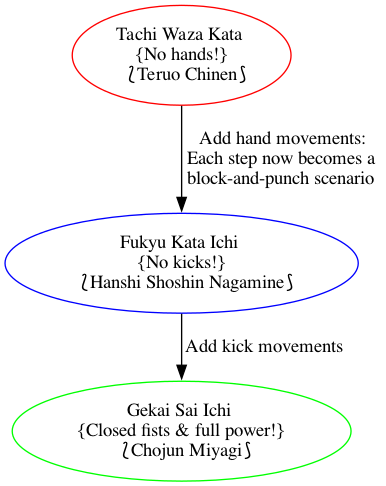
4. Jundokan: Standing in Style Tachi_Waza_Kata
Eiichi Miyazato was a Judo champion and a student of Miyagi; he wanted to pass on Miyagi's legacy and so opened his own training-hall: The Jundokan —which literally means House of Father's Way or House for Following in the Father's Footsteps. Among his famous students is Teruo Chinen, who introduced “Tachi-Waza Kata” into the Jundokan Goju Kata syllabus.
Note: Tachi and Dachi are the same word, in Japanese, meaning stance. The sound changes depending on if the letter is the start of a word.
Above is “Formation 11”, a slight variation of “Dachi-Waza Kata” which is performed as follows.

Starting with heels touching, toes pointing out, and hands to the side.

Musubi-dachi, Joining/United stance; Formal Attention stance
- Heels together, toes open at about 45 degrees;
- Hands move up to waist: Hands remain on the sides of the waist through-out!
- In this stance, the body should be straight, knees are slightly bent, heels are touching and feet are pointing out making a 45° angle.
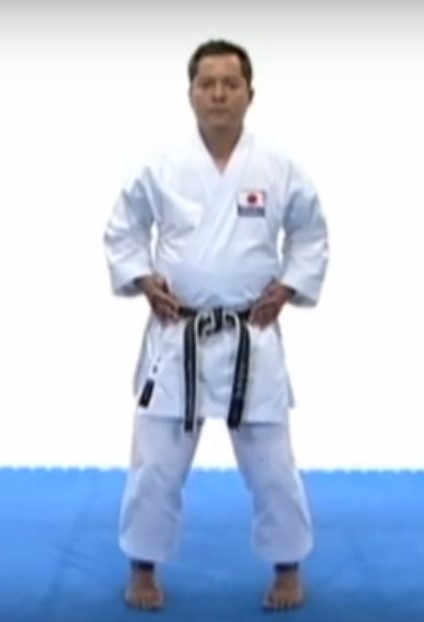
Heiko-dachi, Parallel stance; Attention Stance
- The feet open to shoulder width apart, and their outer edges are parallel.
- In this stance, the feet are shoulder-width apart, the big toes and the second toes should face forward, the inner edges of the feet are parallel, and the center of gravity is at the mid-point between the two feet.
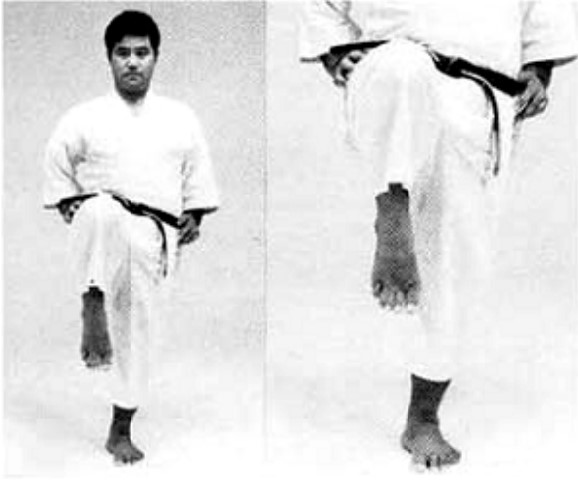 Sagi-ashi-dachi, Heron-foot stance
Sagi-ashi-dachi, Heron-foot stance
- left leg steps to the left, right leg follows then upward with the knee
- In this stance, one leg is raised and bent while the other leg is slightly bent and supports the whole body weight The toe of the raised leg points downward.
- This is also known as Tsuru-ashi-dachi, Crane-foot stance.
- Sagi-ashi-dachi - to the right
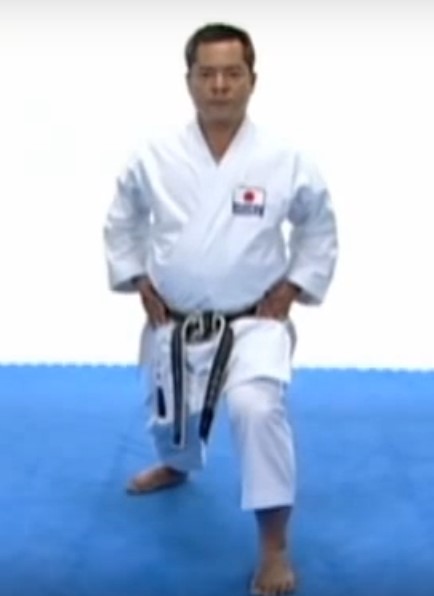
Zenkutsu-dachi, forward stance - to the left
- This is a long frontal stance where the weight is mostly on the front leg.
- It has exactly the same height as shiko-dachi (below), but the rear leg is completely straight at the knee and extended back.
- The front foot is placed frontal (toes facing forward), the rear foot is turned out 30 degrees, but never 90 degrees as seems natural to new practitioners because this precludes any forward motion.
- The heel of the rear foot rests on the ground.
Zenkutsu is performed as follows:
- From the natural stance, step forward so that the distance between the back foot and the front foot is roughly about one and a half to two shoulder width
- The feet are one shoulder width apart
- The front foot points forward and the back foot points diagonally at about 30 degree angle
- The front knee is bent, turned slightly inward, and should be forward enough that you are not able to see the toes
- The back leg is naturally straight but not locked
- Most of the body weight is placed on the front leg
- The heel of the back leg should be placed firmly on the ground.
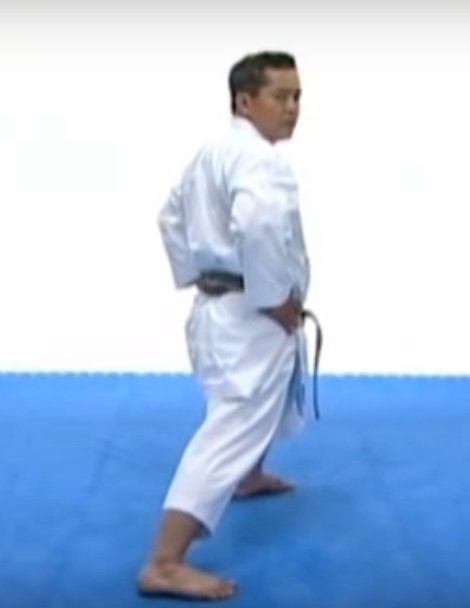
Kokutsu-dachi, Back Long stance - to the right, but head still facing to the left
- This is a back stance derived from the zenkutsu dachi stance.
- Start with zenkutsu dachi, move your back leg across so that the front leg and the back leg are on the same line.
- Zenkustu Dachi - back to the left
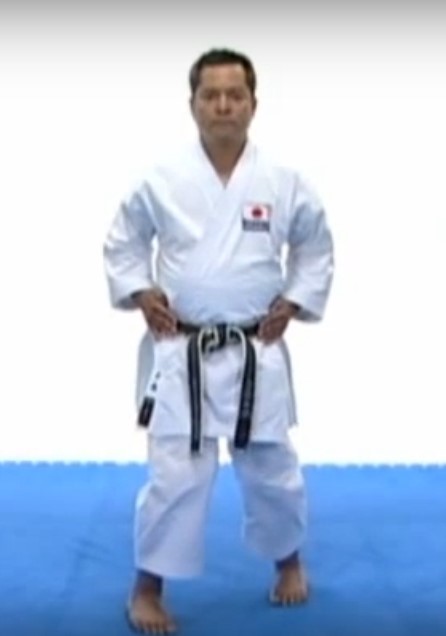
Sanchin-dachi, Three Battle stance - take a step into sanchin, facing leftwards
This is the most difficult stance to master and probably the most important stance in Goju Ryu. It is performed as follows:
- Begin with heiko dachi, step one foot forward
- The heel of the front foot should be on the same line as the toes of the back foot
- The toes of both feet should turn inward slightly
- The front foot is turned inward at about 20° angle
- Tense your tandien, buttocks and thigh muscles and then pull the hips upwards
- The knees should bend and turn inward
- The feet should be placed firmly on the ground with the toes gripping the ground
- The center of gravity should be at the midpoint between the two feet
- Keep your back straight and your chin tucked in.
Sanchin kata, considered the core and most difficult kata in Goju Ryu is done entirely in the sanchin dachi stance.
- Zenkusti Dachi - Look right, then with right leg move into Zenkutsu, then end-up facing rightwards with right leg at the front. Through-out the left remains in-place, just pivoting.
- Kokustu Dachi - to the left, but head still facing to the right
- Zenkustu dachi - back to the right
- Sanchin Dachi - take a step into sanchin, facing rightwards

Hesoku-dachi, feet together stance; informal attention stance - right moves up to touch the left, then head faces to the front center
In this stance, your back is straight and relaxed, your feet are placed together, and the weight is equally distributed between the two feet.
- Zenkustu dachi - to the front center, with left leg leading
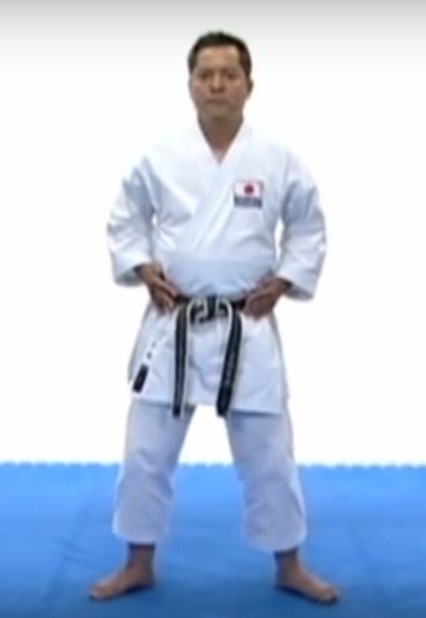 Hachiji-dachi, Natural stance - right leg takes a step forward, left follows, to end-up in a
should-width stance
Hachiji-dachi, Natural stance - right leg takes a step forward, left follows, to end-up in a
should-width stance
- This stance is close to the natural way people stand.
- The feet are shoulder width apart, the toes point out at about 45°, the body is relaxed and the knees are slightly bent.
- Zenkustu Dachi - look over the left-shoulder, turn with left leg; end-up in left leading zenkustu facing the back right corner
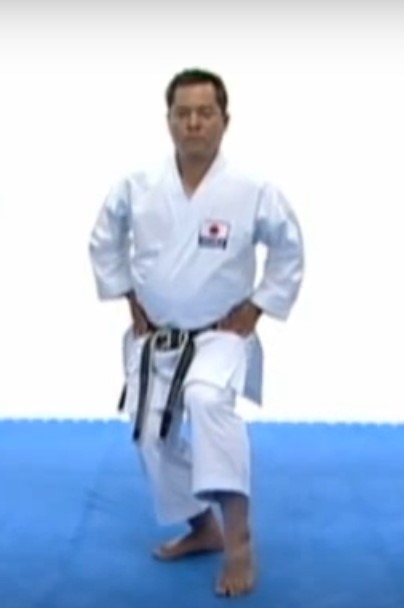
Neko Ashi Dachi, Cat stance - Bring the left back, with toes on ground, heel up.
To assume neko ashi dachi:
- Start with musubi dachi (formal attention stance) and step forward for a distance of about one foot
- Lower the hips deeply and transfer most of the body weight to the back leg
- The front leg is bent and the heel of the front leg is raised slightly with only the toes and the ball of the front foot touches the ground
- The back foot points outward at about 30 to 45 degree angle
- About 90% of the body weight is placed on the back foot.
Note:
- All weight rests on the back leg, which is bent at the knee.
- The rear foot is turned at about 20-30 degrees out and the knee sits at the same angle.
- Only the toes of the front foot rest on the ground, positioned in front of the back heel.
- There is no weight on the front foot, and there is no bent in the ankle joint - front knee, front shin, and the rise of the foot (but not the toes) form a single line.
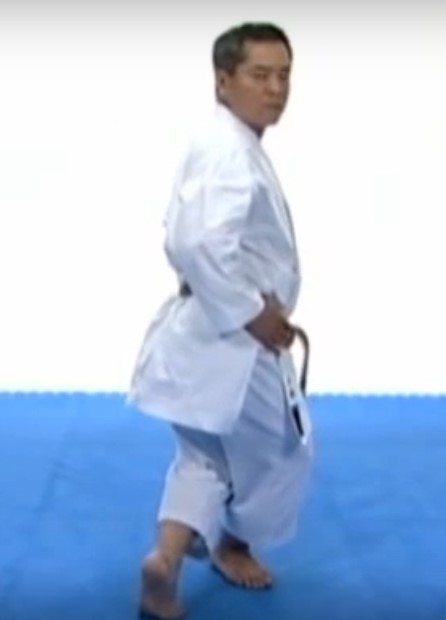 Bensoku-dachi, Cross-legged stance - Drop the left down, toes pointing to the right. Right steps
towards the back right corner of the room. Finally, left leg slides behind
the right leg, ending with the heel up and the toes planted and facing the
right leg.
Bensoku-dachi, Cross-legged stance - Drop the left down, toes pointing to the right. Right steps
towards the back right corner of the room. Finally, left leg slides behind
the right leg, ending with the heel up and the toes planted and facing the
right leg.
To assume bensoku dachi:
- Cross one leg behind the other
- Bend both knees
- The front foot is placed firmly on the ground but only the ball of the back foot touches the ground
- The knee of the back foot is nested against the back of the front knee.
Bensoku dachi is a transitional stance that is used when one needs to change direction. It appears in kata like Seiyunchin and Sepai.
- Zenkustu with the right leg towards the back left of the room; the left leg only pivots.
- Neko Ashi Dachi - Bring the right leg back into a cat stance
- Drop the right down and do a Bensoku Dachi
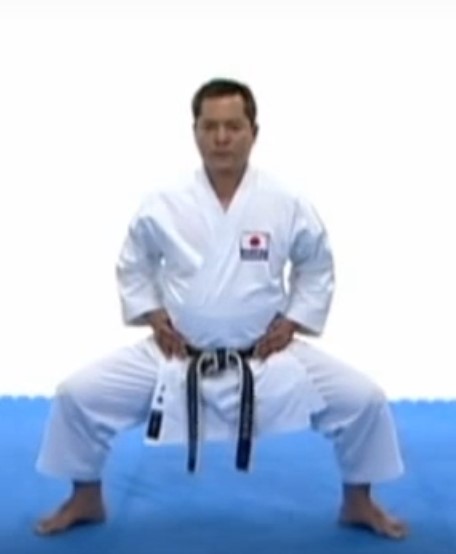
Shiko-dachi, Square Stance, Horse Stance, Straddle Leg Stance
The left leg moves towards the back of the room, ending in a shiko dachi; right leg remains where it is.
The toes face out at about 45 degrees. Knees point outward, and stance is often low.
To assume shiko dachi, start with hachiji dachi stance, turn the heels to point the toes outward at about 45 degrees and lower the hips.
In this stance:
- The feet are about two shoulder width apart
- The big toes point outward diagonally at about 45 degrees
- The knees are turned outward
- The back is straight
- The hips are lower than in kiba dachi and the thighs are almost parallel to the ground
- The body weight is evenly distributed between the two legs
- The soles of the feet are firmly in contact with the ground.
Shiko dachi is a great stance for developing lower body strength and stability.
- Look rightwards towards the center of the room, then do a shiko dachi —ending with body facing the right side of the room; i.e., right leg is in the back.
- Bring the back leg, the right leg, up to the front leg into a Musubu Dachi.
5. Fukyu Kata Ichi
- Kyotsukei, Attention: Palms at sides, arms straight
- Rei, Bow: Eyes slightly down, hands still at sides
- Kamae, Ready stance: heels together Palms down in front of body, L hand over R hand
- Turn left into a left forward stance; down-block with left-hand
- Step forward with right foot into Right forward stance; right middle (solar plexus) punch
- Turn around into a right forward stance, while doing a right down-block
- Move right foot behind body and to the left
- Extend left arm and chamber with right fist at left elbow
- Pivot 180°-rigtwards, on the left-foot, into right forward stance
- Right down block
- Step forward with left foot into left forward stance; left middle (solar plexus) punch
- Turn 90°-leftward, pivoting on the right foot, to face the front; enter into a left Zenkustu; down-block with left
- Step forward with R foot into R forward stance (R foot straight, L foot diagonal)
- R middle (solar plexus) punch
- Step forward with L foot into L forward stance (L foot straight, R foot 45 diagonal)
- L middle (solar plexus) punch
- Step forward with R foot into R forward stance (R foot straight, L foot 45 diagonal)
- R middle (solar plexus) punch
- Move L foot behind body and to the R (move beyond where you extended in step 3 - this time you will end up 225 degrees from start)
- Keeping R arm extended, chamber with L fist on R elbow
- Pivot (on R foot) 225 L into L forward stance -
you are now facing 45 L from back of dojo
- Down block L
- Step forward with R foot into R forward stance (R foot straight, L foot 45 diagonal)
- High block R
- Pivot 90 R (on L foot) into R forward stance -
you are now facing 45 R from back of dojo
- Down block R
- Step forward with L foot into L forward stance (L foot straight, R foot 45 diagonal)
- High block L
- Pivot 45 L (on R foot) into L forward stance - you are now facing back of dojo
- R reverse middle punch
- Step forward with R foot into R forward stance (R foot straight, L foot 45 diagonal)
- L reverse middle punch
- Step forward with L foot into L forward stance
(L foot straight, R foot 45 diagonal)
- R reverse middle punch
- Step forward with R foot into R forward stance (R foot straight, L foot 45 diagonal)
- L reverse middle punch
- Move L foot behind body and to the R (move beyond where you extended in step 3 - you will end up turning 225 degrees to the left)
- Extend R arm and chamber with L fist at R elbow
- Pivot 225 L (both feet) into L forward stance, facing 45 L of dojo front
- Down block L
- Step forward with R foot into R forward stance (R foot straight, L foot 45 diagonal)
- High punch R
- Pivot 90 R (on L foot) into R forward stance Extend L arm and chamber with R fist at L elbow
- Facing 45 R of dojo front Down block R
- Step forward with L foot into L forward stance (L foot straight, R foot 45 diagonal)
- High punch L
- L foot pulls back to starting position, heels together
- Palms down in front of body, L hand over R hand
Note: This is also known as “Kihon Kata Ichi”, Basics Form One.
6. Gekisai Dai Ichi —“Attack & Destroy One”
- Attention stance
- Left foot steps out into Yoi (ready stance) shoulder width apart
- Alternatively: Yoi with feet together at attention left hand over right several inches away from the groin
- the left hand pushes down while the right hand pushes up creating (explosive) tension
- From either Yoi right foot steps forward and you turn left 90 degrees into hourglass stance
- High block with left hand
- If feet are apart in Yoi when the right foot steps forward you pivot on the center (ball and heel) of the foot so that the stance is even
- If feet are together in Yoi left foot pivots on the heel and the right on the ball so the stance is even
- if hands and feet are together in Yoi the right arm explodes from underneath almost like a fanning block before turning
- Step forward into hourglass stance with the right foot
- High punch with the right hand
- Step back into square/horse stance so that the body is facing the direction of the attention stance
- Low block with the left
- Turn the body 90 degrees and left foot slides behind the right into hourglass stance
- High block with the right hand
- Step forward into hourglass stance with the left leg
- High punch with the left hand
- Step back into square/horse stance so that the body is facing the direction of the attention stance
- Low block with the right
- Left leg steps in and then forward into hourglass stance
- Middle block with the left
- Step forward into hourglass stance with the right
- Middle block with the right
- Left front kick and land in a front stance
- Left elbow strike as blocking right hand pulls back into chamber
- Left downward back fist face level
- Left hand transitions to low block
- And right hand punches with a “Kiai”
- Turn right 90 degrees into a ready stance (with head facing to right)
- Right knife hand strike to the side of the temple
- Alternatively: during this transition the back leg of the previous front stance lifts up as if avoiding a sweep
- Turn right 90 degrees to right, step forward with the left into hourglass stance
- Left hand middle block
- Right front kick and land in a front stance
- Right elbow strike as blocking left hand pulls back into chamber
- Right downward back fist face level
- Right hand transitions to low block
- Left hand punches with a “Kiai”
- Turn left 90 degrees into a ready stance (with head facing to left)
- Left knife hand strike to the side of the temple
- Alternatively: during this transition the back leg of the previous front stance lifts up as if avoiding a sweep
- Turn left 90 degrees and left leg steps back into front stance
- As stepping back left hand pulls back as if pulling the arm of an opponent
- Left hand in chamber palm down, right in chamber palm up
- Double punch with left hand to the lungs and right to the stomach
- Alternatively: when stepping back the left hand turns in like an open handed fanning block
- Right hand in chamber comes out and performs a middle block
- Then both hands pull back to chamber with left palm down and right palm up
- Then double punch
- Step forward into ready stance
- Reverse fist orientation
- Alternatively: Step forward feet together, both knees bent
- Right arm turns in as if for a fanning block
- Left arm arcs around in front for a middle block
- Then both hands are pulled back into chamber in the revers orientation they were before in the prior step
- Step back with the right leg into front stance
- Double punch, right hand to the heart and left to the liver
- Step forward into attention stance
- Alternatively: open left hand
- Turn right fist to palm facing up and place it in the open hand
- Open the right hand
- Step forward to attention as the hands turn staying left over right and return to the beginning position
- Bow
Geki Sai Ni is very similar…
7. Closing: Possibly Interesting Reads
- Is Goju-Ryu Karate Any Good? The Answer May Surprise You
- Shorin Ryu Fukyugata Ichi
- Goju-ryu Karate - USAdojo.com
- Don Warrener - Warrener Entertainment
- Publications — Jundokan International
- Jundokan So-Honbu — Jundokan New Zeland
- fukyu kata ichi - Google Search
- JUNDOKAN -
- what does JUNDOKAN mean - Google Search
- List of Goju-Ryu Katas - Black Belt Wiki
- Jundokan Volume 4 - YouTube [Goju documentary]
- The History of Goju Ryu Karate | ART OF ONE DOJO - YouTube
- The Pinan Heian Kata are NOT Children’s Kata! - YouTube
- 5 Ways To Improve Your Motivation For Training | Innovative Martial Arts Academy
- How to become 37.78 times better at anything | Atomic Habits summary (by James Clear) - YouTube
- what is the aim of karate - Google Search
- Karate Philosophy
- Standing Techniques (Stances) - Fierce Tiger Martial Arts Association Budokai - Okinawan Goju Ryu
- Geki Sai Dai Ichi Kata (And Ni!) - Step By Step - YouTube
- Learn Fukyu Kata for Goju Ryu - YouTube
- Perfection of Character: Guiding Principles for the Martial Arts & Everyday Life: Amazon.co.uk: Okazaki, Teruyuki: 9780978576325: Books



Generated by Emacs and Org-mode (•̀ᴗ•́)و

Life & Computing Science by Musa Al-hassy is licensed under a Creative Commons Attribution-ShareAlike 3.0 Unported License

